
Seville, the capital of the region of Andalusia in Spain, has 11 districts, further divided into 108 neighbourhoods.
Casco Antiguo
Main article: Casco Antiguo
The Casco Antiguo (Spanish: Ancient Shell) is the old quarter of Seville, in the centre of the city on the east bank of the Guadalquivir river. Principal tourist attractions are located here, such as the cathedral, the Alcázar, the Torre del Oro, the City Hall, the Palace of San Telmo, the Archivo General de Indias and the Metropol Parasol. Of its twelve neighbourhoods, El Arenal on the riverfront was the port of Seville until the Guadalquivir silted up in the 17th century, while the neighbouring Santa Cruz neighbourhood was a Jewish quarter until the Spanish Inquisition.
The University of Seville is mainly based in the former Royal Tobacco Factory in the south of the Casco Antiguo, the setting to the story and opera Carmen. The city's bullring is in El Arenal.
Neighbourhoods:
- Alfalfa
- Arenal
- Encarnación-Regina
- Feria
- Museo
- San Bartolomé
- San Julián
- San Gil
- San Lorenzo
- San Vicente
- Santa Catalina
- Santa Cruz
Distrito Sur
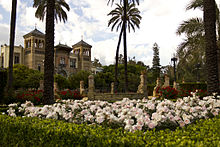
The Distrito Sur (Spanish: South District) lies to the south of the Casco Antiguo on the east bank of the Guadalquivir. It was the location of most of the buildings during the Ibero-American Exposition of 1929: the Plaza de España, the Parque de María Luisa, Archeological Museum of Seville and the Museum of Arts and Traditions of Sevilla.
Neighbourhoods:
- Bami
- Felipe II-Los Diez Mandamientos
- Giralda Sur
- Huerta de la Salud
- El Juncal
- Las Letanías
- La Oliva
- El Plantinar
- Polígono Sur
- El Porvenir
- Prado
- Tabladilla-La Estrella
- Tiro de Línea
Triana
Main article: Triana, Seville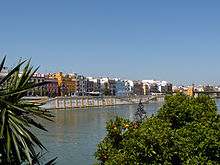
According to legend, Triana is named after the Roman Emperor Trajan, who was born in Italica, a Roman city north of modern Seville. Triana is known as a working-class and gypsy district. It was a centre for the ceramics industry. Like other districts that were historically split from the main city, Triana was known as an arrabal. The district is placed in a near-island position between two branches of the Guadalquivir west of the Casco Antiguo, narrowly linked to the mainland in the north.
This district has many historical buildings, such as the Santa Ana Church and the remains of the San Jorge Castle. The old quarter of the district offers a panoramic view of Seville's city centre. At the north of the district is the island of La Cartuja, a research and development park, site of Expo 92, from which some buildings were kept. The Isla Mágica amusement park is on the island, as is the 60,000-seater Estadio de La Cartuja, built for Seville's unsuccessful bids for the 2000 and 2004 Summer Olympics.
Neighbourhoods:
- Barrio León
- Cartuja
- Tardón
- Triana Casco Antiguo
- Triana Este
- Triana Oeste.
Macarena
Main article: Macarena, Seville

Macarena is the traditional and historical name of the area of Seville located north of the Casco Antiguo on the eastern bank of the Guadalquivir. Nowadays, La Macarena is the name of the neighborhood placed on both sides of the north city wall, but also a much bigger administrative district of Seville. Among other monuments, the Basilica of Nuestra Señora de la Esperanza Macarena, the Macarena Gate and the Parliament of Andalusia are in the district.
El Rinconcillo, a tapas bar built in the 1670s in the Macarena, is the oldest tapas bar in Seville and likely to be the oldest specifically-built tapas bar in the world. The 45-metre-high Torre de Perdigones (Spanish: Tower of Pellets) has been converted into a Camera Obscura with views of the city centre and the Expo 92 site on the Isla de La Cartuja.
Neighbourhoods:
- Las Avenidas
- La Barzola
- Begoña
- La Carrasca
- Campos de Soria
- El Cerezo
- Cisneo Alto
- Cruz Roja
- Doctor Barraquer
- La Fontanilla
- Grupo Renfe
- Hermandades del Trabajo
- Huerta del Carmen
- Macarena Tres Huertas
- Macarena 5
- Miraflores
- La Palmilla-Doctor Marañón
- La Paz-Las Golondrinas
- León XIII-Los Naranjos
- Pino Flores
- Pío XII
- Polígono Norte
- Los Príncipes
- Retiro Obrero
- El Rocío
- San Nicolás
- Santa María de Ordas
- Santas Justa y Rufina
- El Torrejón y Villegas
Nervión
Main article: Nervión, Seville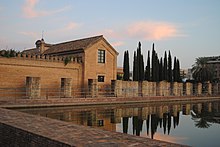
Nervión is in the east of Seville. The district is an important commercial district of the city, where much of the regional capital's business takes place. It is the second focal point of the city, and is home to a number of important sites including Santa Justa, Seville's major train station, with high-speed links via the AVE to Madrid, Córdoba, and Cadiz.
The Estadio Ramón Sánchez Pizjuán is home to Sevilla FC, one of Seville's two football teams in the top flight of La Liga. The area's name is the origin of one of Sevilla FC's nicknames Los Nervionenses. The Facultad de Ciencias Económicas y Empresariales (School of Business) of the University of Seville is in this district.
Neighbourhoods:
- Nervión
- San Bernardo
- Huerta del Pilar
- La Florida
- La Buhaira
- La Calzada
- San Roque
- Ciudad Jardín
Distrito Norte

The Distrito Norte (Spanish: North District) occupies an area to the north of the Macarena on the east bank of the Guadalquivir. The Puente del Alamillo was built before Expo 92 to link across the river to the main Expo sites on the far north of the Isla de La Cartuja.
Neighbourhoods
- Pino Montano
- Consolación
- El Gordillo
- Las Almenas
- San Jerónimo
- La Bachillera
- Los Carteros
- San Diego
- Los Arcos
- Las Naciones-Parque Atlántico-Las Dalias
- San Matías
- Aeropuerto Viejo
- Valdezorras
Los Remedios
Main article: Los Remedios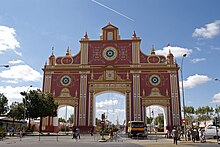
Los Remedios is located on the Isla de La Cartuja on the west bank of the Guadalquivir, to the south of Triana. It derives its name from a Carmelite convent of the same name found in that area. Before development in the latter half of the 20th century, this was one of the few standing structures in what is now Los Remedios. Seville's modern port is in the southern tip of this district, having moved south from the neighbourhood of El Arenal in the Casco Antiguo in the 17th century. Attractions: The Parque de los Príncipes, the Seville Fair, the Puente de San Telmo, the Museo de Carruajes, Los Remedios' tower and the Cuba Square.
Neighbourhoods
- Tablada
- Los Remedios
Este-Alcosa-Torreblanca

Seville's international airport, San Pablo is in this district, which lies on the north bank of the Guadaira, a tributary of the Guadalquivir.
Neighbourhoods
- Colores-Entreparques
- Torreblanca
- Parque Alcosa-Jardines del Edén
- Palacio de Congresos-Urbadiez-Entrepuentes
Cerro-Amate

Attractions: Amate Park and Amate Sports Center.
Neighborhoods:
- Amate
- Juan XXIII
- Los Pájaros
- Rochelambert
- Santa Aurelia-Cantábrico-Atlántico-La Romería
- Palmete
- El Cerro
- La Plata.
Bellavista-La Palmera
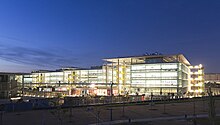
The majority of Bellavista-La Palmera lies in the far south of the city on the eastern bank of the Guadalquivir, opposite the Los Remedios district on the far south of the Isla de La Cartuja. The neighbourhood of Bellavista, lies on the eastern bank of the river Guadaira, a tributary which joins the Guadalquivir soon after. It was bought off the neighbouring city of Dos Hermanas.
Real Betis, a professional association football club, play in the Estadio Benito Villamarín in this district.
Neighbourhoods:
- Bellavista
- Heliópolis
- Elcano-Los Bermejales
- Sector Sur-La Palmera-Reina Mercedes
- Pedro Salvador-Las Palmeritas
- Barriada de Pineda
San Pablo-Santa Justa

Attractions: The Sports Palace of Seville and Kansas City Avenue.
Neighbourhoods:
- Árbol Gordo
- La Corza
- Las Huertas
- San Carlos-Tartessos
- San José Obrero
- El Fontanal-María
- Auxiliadora-Carretera de Carmona
- Santa Clara
- Zodiaco
- San Pablo A y B
- San Pablo C
- San Pablo D y E
- Huerta de Santa Teresa
References
- "El Arenal, Sevilla".
- "Santa Cruz - Culture".
- "Triana, Sevilla".
- "Triana, Sevilla".
- "Olympic Games: 11 cities bid to stage 2004 Games". Independent.co.uk. 11 January 1996.
- "CNN/SI - Olympics - Seville seeking 2008 Olympic bid - Wednesday May 05, 1999 12:37 PM". Archived from the original on 9 March 2013. Retrieved 2 June 2012.
- "No etiquette in Seville's oldest tapas bar - Savoury Planet".
- "Cámara Oscura de la Torre de los Perdigones - Cámara Oscura". Archived from the original on 26 May 2011. Retrieved 3 June 2012.
- Roy, Shourin (21 August 2009). "Why do English clubs have such boring and redundant names?". SoccerBlog.com. Retrieved 15 September 2011.
- "Facultad de Ciencias Económicas y Empresariales - Universidad de Sevilla". Archived from the original on 21 June 2012. Retrieved 2 June 2012.